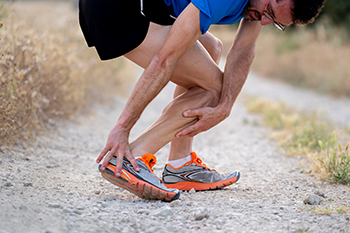
Suffering from plantar fasciitis is no joke. This inflammatory condition affects the tissue in the sole of the foot, causing arch and heel pain that can be excruciating. Those most at risk of plantar fasciitis are runners and people who stand for long periods throughout the day. Factory workers, teachers, construction and warehouse workers, and people who work in restaurants or hospitals are at higher risk. Ways to prevent plantar fasciitis include investing in proper footwear, performing a series of strengthening and stretching exercises, and wearing orthotic inserts in your shoes. The most common cause of plantar fasciitis, by far, is running. The constant pounding on hard surfaces causes tiny tears in the plantar fascia, which then becomes inflamed. Well-cushioned footwear is essential, as the activity that produces plantar fasciitis can also affect the foot, ankles, legs, and knees. For more information about treating plantar fasciitis, it is suggested that you consult a podiatrist.
Plantar fasciitis can be very painful and inconvenient. If you are experiencing heel pain or symptoms of plantar fasciitis, contact one of our podiatrists from Riznyk Podiatry. Our doctors can provide the care you need to keep you pain-free and on your feet.
What Is Plantar Fasciitis?
Plantar fasciitis is the inflammation of the thick band of tissue that runs along the bottom of your foot, known as the plantar fascia, and causes mild to severe heel pain.
What Causes Plantar Fasciitis?
How Can It Be Treated?
While very treatable, plantar fasciitis is definitely not something that should be ignored. Especially in severe cases, speaking to your doctor right away is highly recommended to avoid complications and severe heel pain. Your podiatrist can work with you to provide the appropriate treatment options tailored to your condition.
If you have any questions please feel free to contact our office located in Orchard Park, NY . We offer the newest diagnostic and treatment technologies for all your foot and ankle needs.

Foot comfort is essential to have at all times, and especially during the work day. Many people have jobs that require mandatory standing during the majority of the day, which may lead to foot injuries. Research has shown there are two categories of foot injuries that can happen while working. Sprains, punctures, cuts, or similar injuries comprise one area and injuries that occur from slipping and tripping fall into another category. Additionally, many people develop ingrown toenails, calluses, or blisters from wearing shoes that do not fit correctly. Most injuries can cause discomfort, fatigue, and pain, and may affect the foot muscles and joints. It is beneficial for companies to provide stress mats for their employees to stand on, in addition to providing ample time for breaks. If you would like more information about how to protect your feet while working, it is suggested that you confer with a podiatrist who can provide you with the information you are seeking.
While working on the feet, it is important to take the proper care of them. For more information about working on your feet, contact one of our podiatrists from Riznyk Podiatry. Our doctors will treat your foot and ankle needs.
Working on Your Feet
Standing on your feet for long periods of time can cause stress and pain in your feet. Your whole body may experience change in terms of posture, back pain, bunions, callouses and or plantar warts. There are ways to avoid these conditions with proper foot care, smart choices and correct posture.
Positive Changes
Negative heeled shoe – Choosing this shoe type places the heel slightly lower than the ball of the foot. These are great for overall foot health. Find shoes that fit you correctly.
Go barefoot – Our feet were not designed to be enclosed for all hours of the day. Try to periodically expose your feet to air.
Eliminate Pain
Foot Exercises – Performing simple exercises, incorporating yoga and doing stretches are beneficial. This will allow increased blood flow to the area and muscles of the foot.
Achilles tendon – Stretching the foot out flat on the floor will relax the calf muscles and tendon. These exercises can be performed almost anywhere. Make sure you add these exercises to your daily regimen.
With a little bit of this information and knowing more about foot health, you will notice changes. Foot stretches and proper footwear will help with pain and prevent further issues.
If you have any questions please feel free to contact our office located in Orchard Park, NY . We offer the newest diagnostic and treatment technologies for all your foot and ankle needs.

When a stress fracture is incurred, it can be a runner’s worst nightmare. A stress fracture is a hairline fracture that happens from increased pressure on the feet while participating in running and jumping activities. Some patients have a predisposition to stress fractures, which may include having weak and narrow bones. The minimum recovery time for a complete recovery is six weeks and it is imperative to the healing process that running is stopped during this time. When the foot has healed, it is beneficial to begin running gradually and increase speed and distance slowly. Additionally, it can help to perform basic foot stretches to give the foot a chance to become stronger. If you have foot pain and are unable to run, it is suggested that you contact a podiatrist who can determine if a stress fracture has occurred, and offer you the correct treatment options.
Stress fractures occur when there is a tiny crack within a bone. To learn more, contact one of our podiatrists from Riznyk Podiatry. Our doctors can provide the care you need to keep you pain free and on your feet.
How Are They Caused?
Stress fractures are the result of repetitive force being placed on the bone. Since the lower leg and feet often carry most of the body’s weight, stress fractures are likely to occur in these areas. If you rush into a new exercise, you are more likely to develop a stress fracture since you are starting too much, too soon. Pain resulting from stress fractures may go unnoticed at first, however it may start to worsen over time.
Risk Factors
Stress fractures do not always heal properly, so it is important that you seek help from a podiatrist if you suspect you may have one. Ignoring your stress fracture may cause it to worsen, and you may develop chronic pain as well as additional fractures.
If you have any questions, please feel free to contact our office located in Orchard Park, NY . We offer the newest diagnostic and treatment technologies for all your foot care needs.

Running is great for staying in shape, and many people enjoy this type of exercise on a regular basis. For that reason, keeping the feet healthy and free of injury is paramount to running pain free. People with flat feet or high arches, or people who overpronate, may be more at risk for typical foot injuries caused by running. Probably the most common foot injury in runners is plantar fasciitis. This inflammation of the plantar fascia, a band of tissue that runs from the toes to the heels, can cause excruciating heel pain. It is likely to be caused by overtraining and is considered a repetitive stress type of injury. Resting the feet, performing suggested exercises, and taking anti-inflammatory medication can help. Metatarsalgia, or pain in the ball of the foot, is another common runner’s injury. It is caused by exerting too much pressure on the long bones of the foot. Also common to runners is a condition called Morton’s neuroma, where the nerves in the foot become entrapped by fibrous tissue. This can cause burning and tingling, numbness, or shooting pain. If you are an avid runner, it is suggested that you consult a podiatrist if you experience these types of injuries.
All runners should take extra precaution when trying to avoid injury. If you have any concerns about your feet, contact one of our podiatrists of Riznyk Podiatry. Our doctors will treat your foot and ankle needs.
How to Prevent Running Injuries
There are a lot of mistakes a runner can make prior to a workout that can induce injury. A lot of athletes tend to overstretch before running, instead of saving those workouts for a post-run routine. Deep lunges and hand-to-toe hamstring pulls should be performed after a workout instead of during a warmup. Another common mistake is jumping into an intense routine before your body is physically prepared for it. You should try to ease your way into long-distance running instead of forcing yourself to rush into it.
More Tips for Preventing Injury
If you have any questions, please feel free to contact our office located in Orchard Park, NY . We offer the newest diagnostic and treatment technologies for all your foot care needs.